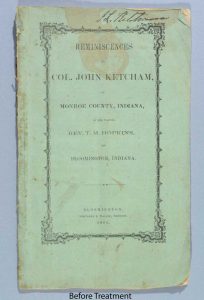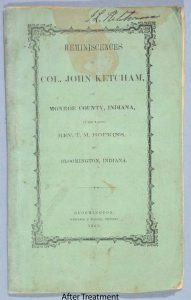
Plan your visit
Ethics, Color Matching and Pamphlet Repair
April 26, 2018

My favorite part of working at IHS is the challenge of conserving objects and stabilizing them so that they can be safely used. This treatment was an opportunity for me to practice a thought process on ethical conservation, color toning, and to pick the brains of my insightful supervisors even more!

This pamphlet consists of three different sections that were stab sewn together, a binding type that is typical of pamphlets and other ephemeral objects. The binding was badly damaged, broken at the top half and straining the binding holes and even ripping the paper (pictured below). The first step was to remove the binding to allow surface cleaning and to mend any tears. The green cover was adhered to the front and back of the first and last pages of the pamphlet to hide the binding. These cover pages were originally a single folio but had split along the spine. Once the pamphlet was taken apart, the pages were locally humidified to loosen the adhesive and allow for mechanical detachment.

A link-stitch was chosen to reassemble the pamphlet; this option allows the pamphlet to lie flat while open and causes less stress on the pages when turned. Changing the original binding was not taken lightly. Pros and cons were weighed; the major con is that this new sewing structure isn’t original to the piece. We felt the stability and the longevity of the pamphlet and the ability to safely read the pamphlet justified the change. While this thought process is used all the time in conservation, sometimes the piece has to be aesthetically altered. Hinges were adhered to the two cover pages and bound to the top and bottom of the text block.

This treatment is a great example of a stabilization in which we were able to keep the intended look of the object. By toning the long-fibered tissue paper that we use for mends, I was able to replicate the color of the cover as closely as possible to make the paper mend even more seamless. I attempted a few different methods in order to create different values of the color, including watering down the paint. Acrylic paints tend to dry darker so a variety of tones helped me find one that matched the pamphlet even after it had been adhered, which can darken the tissue even more. It took a try or two to find the right color match but the treatment of this piece was finalized by adhering the toned tissue to the front and back covers, concealing the new binding and mending the torn cover back together.









